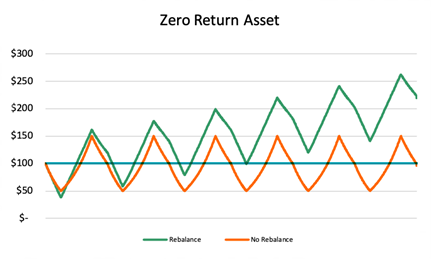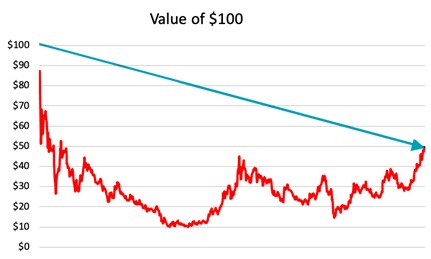Surprise! Even Conservative Investors Could Profit on Bitcoin
Risk is misunderstood. Here’s one way to use a volatile asset – and Bitcoin is about as volatile as investments get – to help your portfolio.


Money managers have two top priorities: identifying and investing in non-correlated assets, and rebalancing around volatility. With the ups and downs of the past year, it’s a perfect time to discuss the value of volatility and how a sound rebalancing process can harvest it to add value.
Let’s start with a hypothetical: If an asset has a return of zero percent over the long term, can it add significant value to an investor? The answer lies in its volatility.
Here is a graph of the hypothetical asset. It returns zero percent over the long term, but it experiences large swings, going down 50%, returning to even, going up 50%, and then back down to even. Over and over again.
From just $107.88 $24.99 for Kiplinger Personal Finance
Become a smarter, better informed investor. Subscribe from just $107.88 $24.99, plus get up to 4 Special Issues

Sign up for Kiplinger’s Free Newsletters
Profit and prosper with the best of expert advice on investing, taxes, retirement, personal finance and more - straight to your e-mail.
Profit and prosper with the best of expert advice - straight to your e-mail.

Say someone makes an initial investment of $100 in this asset, and their money manager/adviser places a rebalancing strategy around the holding. If the value of the holding drops 20%, buy it back up to $100, or buying low-ish. If the value rises 25%, sell it back to $100, or selling high-ish.
Over time, the portfolio would then look like this:

The buy-and-hold portfolio generates a total return of zero percent. The rebalanced portfolio generates a total return of 119%, or an average annual return of 14%.
Note: If, perhaps, you have a crystal ball and know that an asset will only go down, don’t buy it! If your crystal ball indicates that an asset will only go up, never sell it. But if you don’t have a crystal ball — and since historically assets experience both ups and downs — a rebalancing strategy is actually what matters.
Volatility, if used correctly, is an investor’s friend.
Bitcoin has been among the most volatile assets of all time. But the more volatile an asset, the less of it you want in a portfolio. Currently, there is only one way to purchase Bitcoin in a brokerage account, which is through the Grayscale Bitcoin Trust, ticker GBTC.
Let’s run a fictitious study… assuming you purchased GBTC at its all-time high, on Dec. 18 of 2017. This would have been the worst possible day to make the purchase. The price was $38.05 per share (the current price is around $20). Here is what would have happened to your $100 investment.

The buy-and-hold investor would have lost around half of their money. Now, let’s put a rebalancing strategy around this. If it goes down 33%, buy some. If it goes up 50%, sell some. Remember there is nothing magic about the rebalance parameters presented here … almost any reasonable parameters provide value. The parameters used here are not intended to maximize results, but are roughly based on volatility.

The rebalancing strategy took an asset that lost half of its value and turned it into a positive 70% return.
An investor does not need a positive view on Bitcoin, only an understanding of its volatility. No one knows what the future holds. In the medium-term, the volatility of Bitcoin is likely to add value to portfolios merely through a sound rebalancing process.
How much of a volatile asset should you own?
If you believe that an asset will behave in a different manner than the rest of your portfolio, the question isn’t whether you should own it. The question is how much of it you should own? Bitcoin will, of course, behave differently than the average portfolio, but by harvesting volatility, you can add value over time.
One should not go crazy here. Remember: The more volatile an asset, the less of it you should own. A 2% position won’t make or break you. Again, there’s no crystal ball. But rebalancing is key to navigating how valuable it can be.
Profit and prosper with the best of Kiplinger's advice on investing, taxes, retirement, personal finance and much more. Delivered daily. Enter your email in the box and click Sign Me Up.

Randy Kurtz, RIA, CFP®, is a nationally recognized expert on risk. Challenging the financial industry's status quo for over a decade, Kurtz feels the standard Wall Street portfolio comes with far more risk than clients realize. He created a method of investing that aims to lower excess risk taken in client portfolios, without reducing expected return. His goal is to transform the industry by turning the client-adviser relationship from a return-centered conversation to a risk-centered one.
-
 Dow, S&P 500 Rise to New Closing Highs: Stock Market Today
Dow, S&P 500 Rise to New Closing Highs: Stock Market TodayWill President Donald Trump match his Monroe Doctrine gambit with a new Marshall Plan for Venezuela?
-
 States That Tax Social Security Benefits in 2026
States That Tax Social Security Benefits in 2026Retirement Tax Not all retirees who live in states that tax Social Security benefits have to pay state income taxes. Will your benefits be taxed?
-
 QUIZ: What Type Of Retirement Spender Are You?
QUIZ: What Type Of Retirement Spender Are You?Quiz What is your retirement spending style? Find out with this quick quiz.
-
 This Is How Early Retirement Losses Can Dump You Into Financial Quicksand (Plus, Tips to Stay on Solid Ground)
This Is How Early Retirement Losses Can Dump You Into Financial Quicksand (Plus, Tips to Stay on Solid Ground)Sequence of returns — experiencing losses early on — can quickly deplete your savings, highlighting the need for strategies that prioritize income stability.
-
 How an Elder Law Attorney Can Help Protect Your Aging Parents From Financial Mistakes
How an Elder Law Attorney Can Help Protect Your Aging Parents From Financial MistakesIf you are worried about older family members or friends whose financial judgment is raising red flags, help is out there — from an elder law attorney.
-
 Q4 2025 Post-Mortem From an Investment Adviser: A Year of Resilience as Gold Shines and the U.S. Dollar Dives
Q4 2025 Post-Mortem From an Investment Adviser: A Year of Resilience as Gold Shines and the U.S. Dollar DivesFinancial pro Prem Patel shares his take on how markets performed in the fourth quarter of 2025, with an eye toward what investors should keep in mind for 2026.
-
 Is Your Emergency Fund Running Low? Here's How to Bulk It Back Up
Is Your Emergency Fund Running Low? Here's How to Bulk It Back UpIf you're struggling right now, you're not alone. Here's how you can identify financial issues, implement a budget and prioritize rebuilding your emergency fund.
-
 An Expert Guide to How All-Assets Planning Offers a Better Retirement
An Expert Guide to How All-Assets Planning Offers a Better RetirementAn "all-asset" strategy would integrate housing wealth and annuities with traditional investments to generate more income and liquid savings for retirees.
-
 7 Tax Blunders to Avoid in Your First Year of Retirement, From a Seasoned Financial Planner
7 Tax Blunders to Avoid in Your First Year of Retirement, From a Seasoned Financial PlannerA business-as-usual approach to taxes in the first year of retirement can lead to silly trip-ups that erode your nest egg. Here are seven common goofs to avoid.
-
 How to Plan for Social Security in 2026's Changing Landscape, From a Financial Professional
How to Plan for Social Security in 2026's Changing Landscape, From a Financial ProfessionalNot understanding how the upcoming changes in 2026 might affect you could put your financial security in retirement at risk. This is what you need to know.
-
 6 Overlooked Areas That Can Make or Break Your Retirement, From a Retirement Adviser
6 Overlooked Areas That Can Make or Break Your Retirement, From a Retirement AdviserIf you're heading into retirement with scattered and uncertain plans, distilling them into these six areas can ensure you thrive in later life.